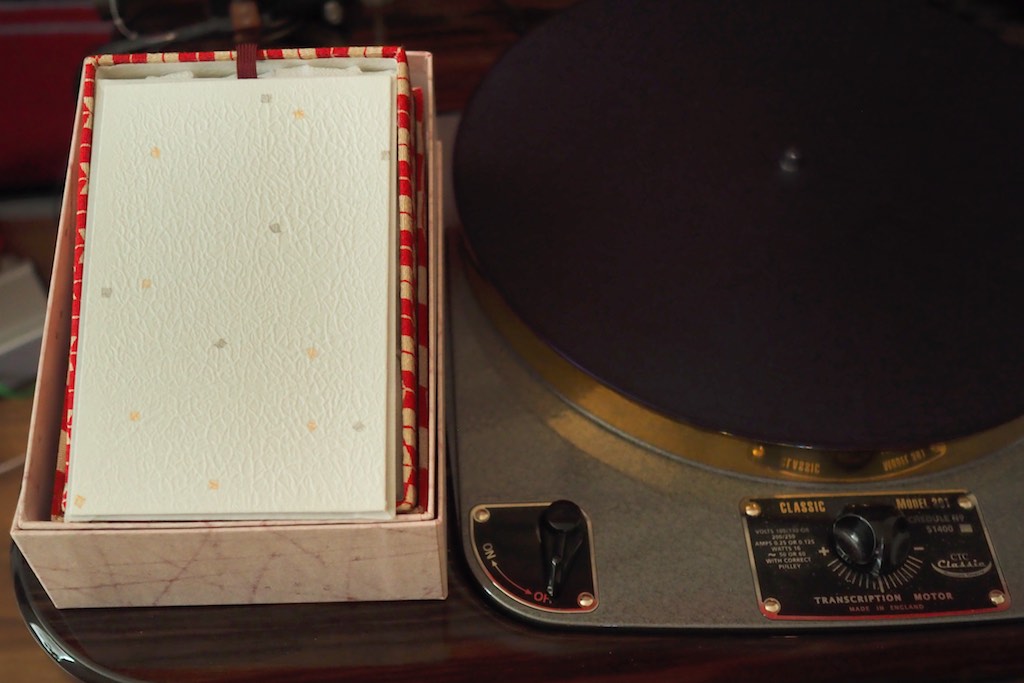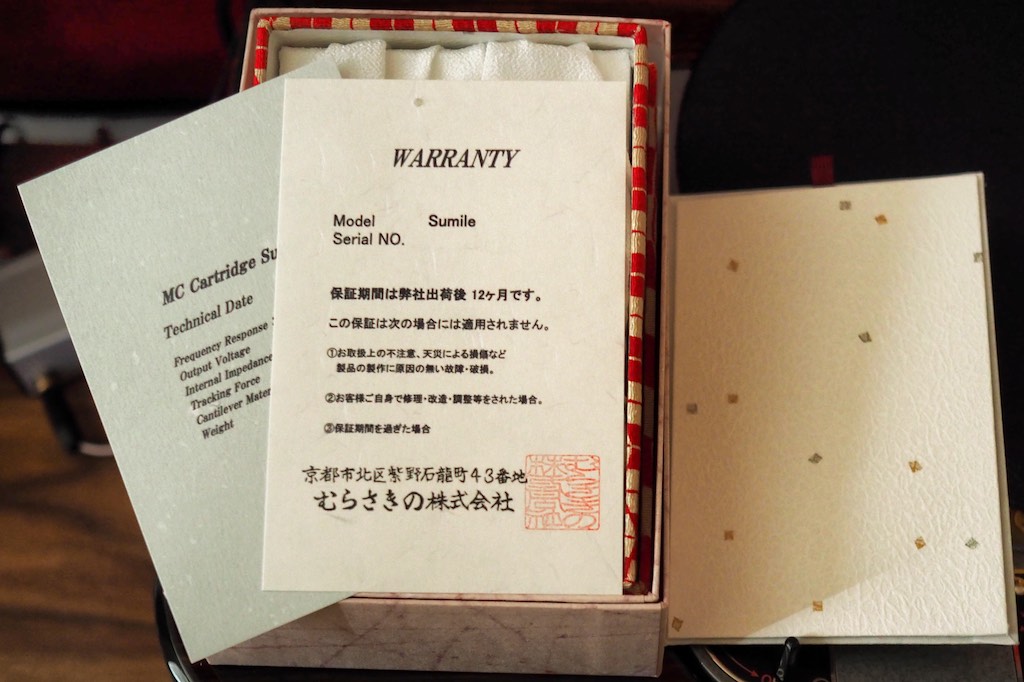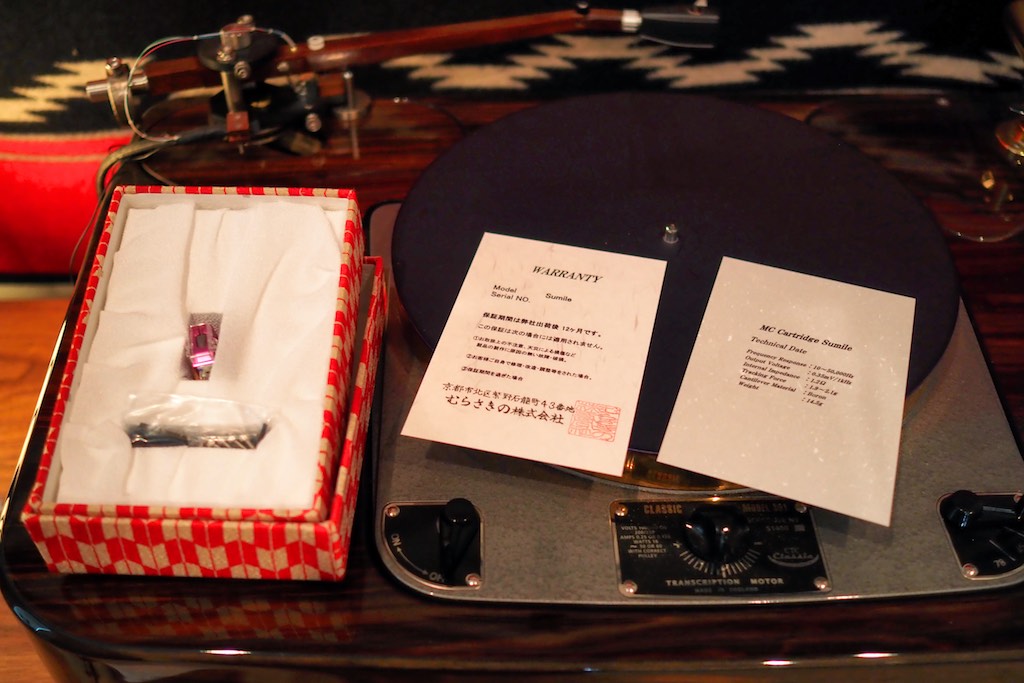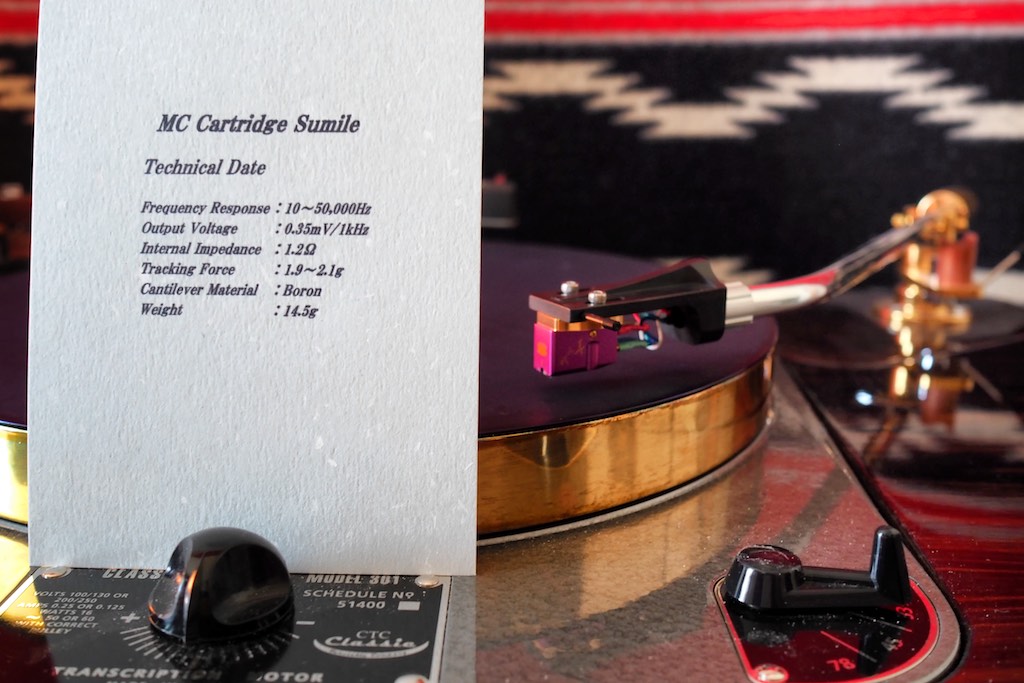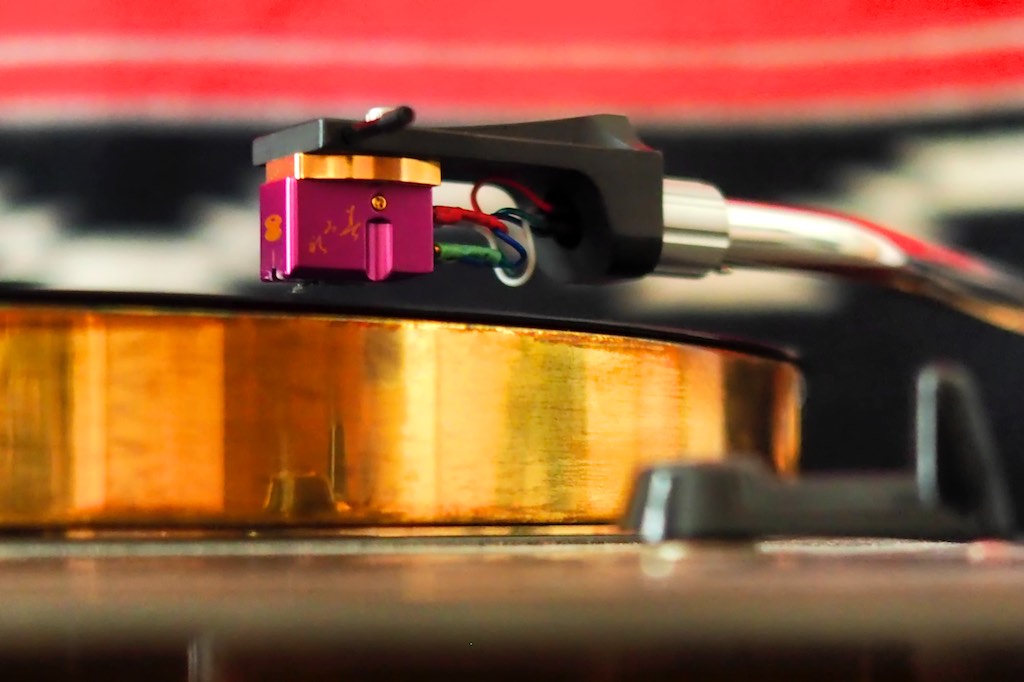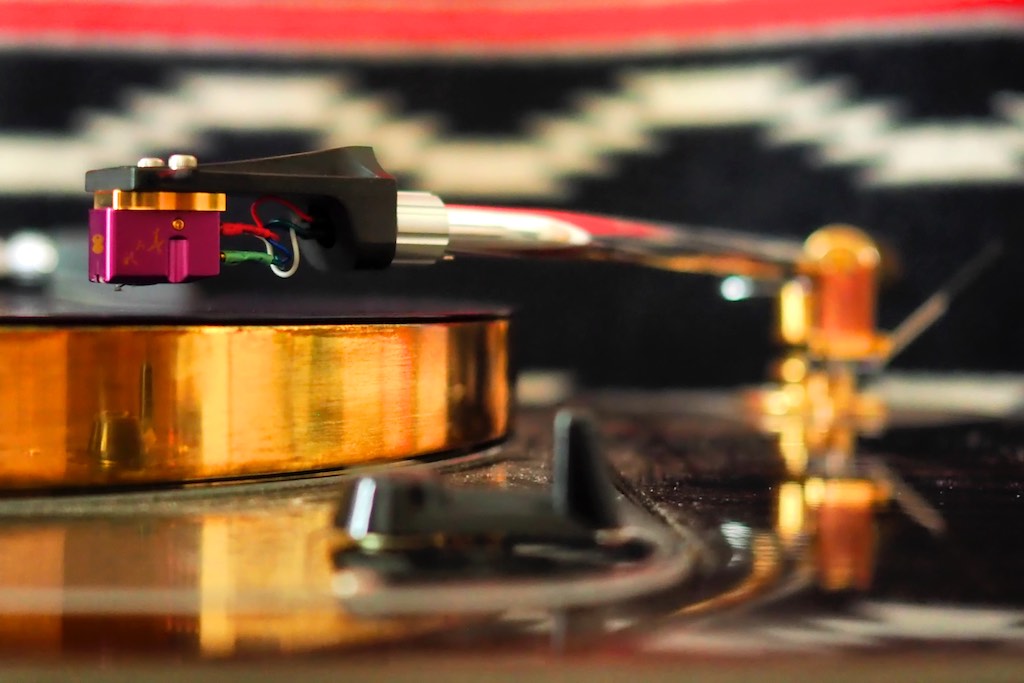I've mentioned before that I get pretty excited whenever I hear from Yoshi-san & Elia-san (father & son) of the MuSon Project in Osaka, Japan, who export Japanese audio exotica to The World, because it means that something exciting is about to happen audio-wise!

Jeff hangin' at the 2015 Rocky Mountain Audio fest with Yazaki-san, Nishimiya-san, Dave Clark-san, Ishimi-san, Alan Kafton-san, Yoshi Hontani-san, and Elia Hontani-san. What a great group of guys!
Yoshi-san told me that he had a new phonograph cartridge that he wanted me to listen to that has created quite a bit of sensation for those that have heard it in Japan & Europe, the Murasakino Ltd. Sumile moving-coil phonograph cartridge from Japan!
By the way, "Sumile" is pronounced similar to "smile", and the Sumile certainly made me smile when I examined this exotic and beautifully hand-crafted moving-coil phonograph cartridge - it's gorgeous!
A little background. First of all, the name of the Sumile comes from the color of the cartridge's body, which is violet in color. "Su.Mi.Le" are the Japanese alphabet letters that make up the Japanese word "Sumile", which means means “violet” in Japanese.

Location of Kyoto (purple) in the Kyoto Prefecture. Murasakino is located in the Northern part of Kyoto. Image courtesy of Wikipedia.
Also, the name of the company - Murasakino - is taken from the location of the company in the Northern part of Kyoto.
Murasaki means "purple" in Japanese, and Murasakino means "purple land" or "purple fields" in Japanese, and correspondingly, the logo for Murasakino is purple.
I would suggest that the color purple also signifies royalty & nobility, which would correspond to Kyoto historically being the Imperial capital of Japan for more than a thousand years.
Yoshi-san sent me the following message from Mr. Daisuke Asai, the owner of Murasakino Ltd., and the designer of the Sumile phono cartridge.
In his message Mr. Daisuke Asai introduces himself and his design concept for the Sumile:
First of all, let me introduce myself. I am Daisuke Asai from Murasakino Ltd.
Almost all of the information on the Sumile is available on our website, but I would like to provide you some supplemental information.
First, I will explain the relationship between output voltage and impedance.
I believe the most important consideration in designing a MC cartridge is the balance between the output voltage and impedance.
From the very beginning of the Sumile design and production-planning processes, we maintained the output voltage at 0.35 mV or higher, and the impedance at 1.2 ohms.
I am certain that our specifications for the Sumile output voltage and impedance, which are 0.35 mV and 1.2 ohms, respectively, represent the best balance between voltage and impedance.
Why do we use stainless steel to construct the base of the cartridge? We were inspired by the use of stainless steel in Durand Tonearms, a prestigious tonearm manufacturer in the USA (Durand Tonearms is a Washington State company, located in Seattle, not far from me - Jeff).
These tonearms are highly sophisticated and durable; thus, we used stainless steel to construct the base, on which the power-generation system is mounted.
Additionally, I would like to mention that we have been testing the Sumile cartridge since its prototype stage using the Durand Tonearms The Kairos™ model.
Why do we use gold-plated stainless steel? The stainless-steel base of the cartridge is plated to improve the overall sound quality. I devised this idea from my experience in playing the oboe, a wind instrument. The tube of an oboe is made of Grenadilla wood. The sound quality varies to a large extent with the quality of the plating finish on the keys, which are made of metal, imbedded into the wooden tube, and pressed using fingertips.
I believe that gold-plating the keys adds softness and beauty to the sound; this is why we use a gold-plated stainless-steel base.
Let me explain the calligraphy printed on the cartridge as well as its meaning.
The style of Japanese calligraphy used in the model name on the side of the cartridge was developed by the chief priest of a temple in Kyoto. This type of Japanese writing is called “Kanamoji” or sometimes just “Kana,” and is only used in Japan. (You can read more about this unique writing here and here. - Jeff)
Finally, I will explain the logo.
As you can see on the front of the cartridge, the logo design comprises two vertically stacked circles. The circle at the top figuratively represents a disk or phono-record, and the one at the bottom represents the platter of a turntable.
By making these two circles contact each other, we attempted to figuratively represent the moment when the disk is placed onto the platter.
This is supposedly the most exciting moment for analog-music enthusiasts when they play a record.
After the package arrived from Yoshi-san & Elia-san I opened it up to find the securely packed and tasteful craft-paper Sumile box, with its artsy patterned & violet-hued finish.
Upon opening the Sumile's exterior box, within I found another protective box covered in a burgundy & cream patterned fabric (silk?).
Upon opening the inner box I found a nice art paper & fabric cover, and the warranty & specifications cards.
And under those - Voilà! - was the Sumile cartridge along with some mounting tools & screws.
Normally I wouldn't say much about packaging, but the Sumile's was done so artfully, and with such care & attention to detail, that I thought it was worth mentioning, because that same artful attention to detail is what sets the Sumile apart not only in packaging, but in its design & construction as well.
As I held the Sumile in my hand and inspected it's ultra-quality of materials, hand-crafted nature, and impeccable fit & finish, I certainly got a sense of the royalty & luxury & quality evoked by this exotic gem of a cartridge, which I'm sure is what Mr. Daisuke Asai of Murasakino Ltd., who designed the Sumile, intended for their "ultimate analog product".
When I look at the Sumile, touch it, and read through Mr.Daisuke Asai's message, it is obvious to me that he has put a great deal of listening, insight, and care, into building his vision for the ultimate moving-coil phono cartridge in the Sumile.
As you can see printed on the included technical data card for the Sumile (below), the specifications are as follows:
- Frequency Response: 10 to ~50,000Hz
- Output Voltage: 0.35mV/1kHz
- Internal Impedance: 1.2 Ohms
- Tracking Force: 1.9 to 2.1 grams
- Cantilever Material: Boron
- Weight: 14.5 grams
The impedance is kept low by reducing the number of turns in the coil, but the fewer the coil turns there are, the lower the output voltage tends to be.
However, in the Sumile's case the output voltage is 0.35mV, which is quite a bit higher than my Ortofon SPU Classic GM MkII's 0.2mV, slightly higher than my Denon DL-103's 0.3mV, and quite a bit lower than my EMT TSD-15N's output of 1.05mV.
The Sumile moving-coil cartridge has a low internal impedance of 1.2 Ohm. In comparison, my Ortofon SPU Classic GM MkII has an impedance of 2 Ohms, my EMT TSD-15N has an impedance of 24 Ohms, and my Denon DL-103 has an impedance of 40 Ohms.
So the 1.2 Ohms of the Sumile is very low indeed, which should be taken into account when matching it with a step-up transformer (SUT), as it's more toward the lowish SPU internal impedance end of the spectrum (2 Ohms) - but even lower at 1.2 Ohms - than at the higher internal impedance end of the spectrum, like the venerable Denon DL-103's 40 Ohms.
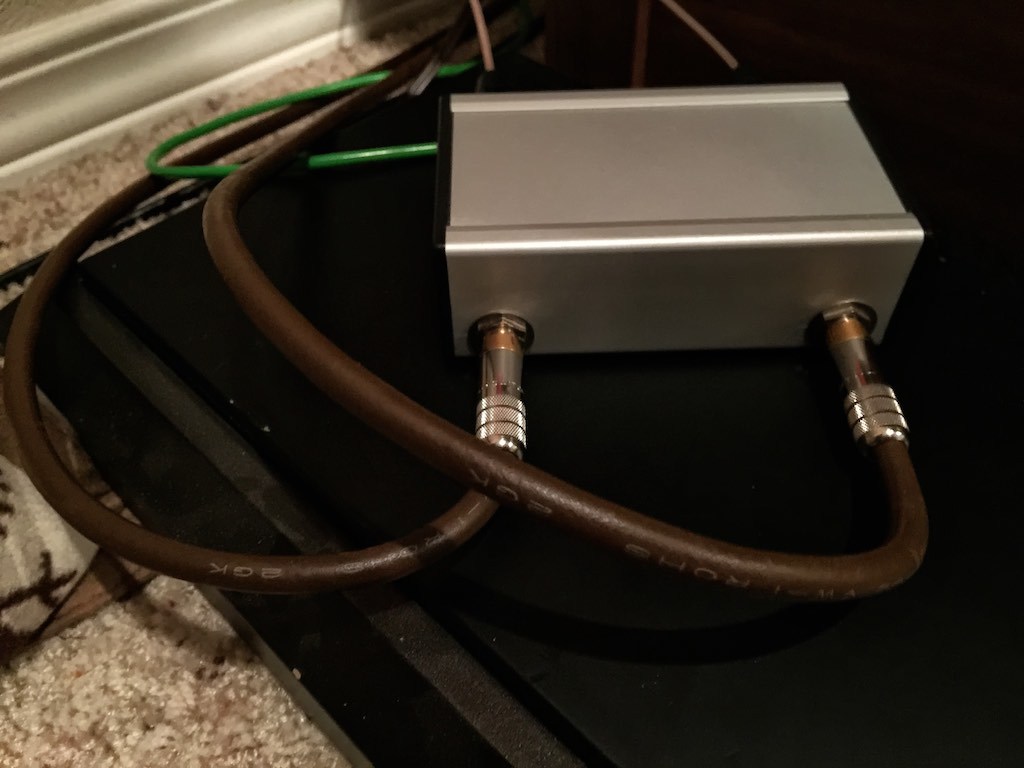
The Auditorium 23 SUT that Keith Aschenbrenner designed to compliment the Denon DL-103 phono cartridge.
I asked Yoshi-san if would like to recommend a step-up transformer (SUT) that would be a suitable match to the Sumile's low 1.2 Ohm internal impedance, mentioning that I have an Auditorium 23 SUT designed by Keith Aschenbrenner that is optimized for the Denon DL-103 phono cartridge's 40 Ohm internal impedance (above), and a bespoke SUT by Dave Slagle of Intact Audio that I use for my Ortofon SPU Classic GM MkII (below), optimized for it's 2 Ohm internal impedance.
Yoshi-san responded, and told me:
Dear Jeff,
As the impedance of the Sumile cartridge is very low (1.2ohms), the SUT for your Ortofon SPU might be better.
However, it is electrically no problem to use a SUT with higher impedance than the Sumile cartridge, so the SUT for your Denon DL-103 should present no problem, and you can compare the sound with the two different SUTs.
As you can tell from the accompanying photos, I mounted the Sumile to my favorite headshell, the superbly musical Thomas Schick graphite headshell, then installed it into my 12-inch Schick tonearm.
After getting the cartridge adjusted properly, I decided to try it first with Auditorium 23 SUT, then I thought I'd give it a go with my bespoke Intact Audio SUT, and hear what happens.
After I fiddle around with some different interconnects, SUTs, and tonearms for the Sumile, I'll post some preliminary listening impressions.
The Murasakino Sumile MC phonograph cartridge will be distributed in North America by Jonathan Halpern through Tone Imports, which is really good news for North American audio enthusiasts, as Jonathan is well known for his extremely good taste in all things music & audio, as well as his impeccable customer service.
The retail price in North America of the Murasakino Sumile MC phonograph cartridge is expected to be in the $9000 USD range.
Ok, that's it for now, and I hope you've enjoyed my introduction of the Murasakino Sumile MC phonograph cartridge.
As always, thanks for stopping by, and may the tone be with you!








